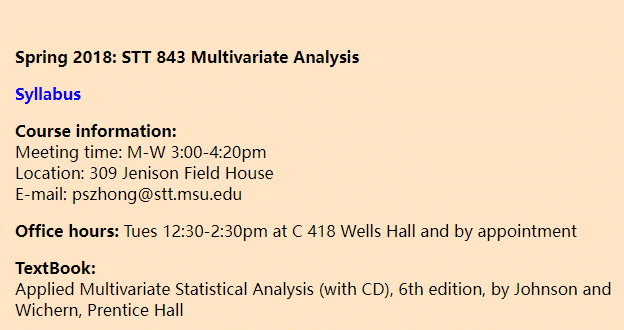MY-ASSIGNMENTEXPERT™可以为您提供 stt.msu STT843 Multivariate Statistical Analysis多元统计分析的代写代考和辅导服务!
这是密歇根州立大学多元统计分析课程的代写成功案例。

STT843课程简介
Course information:
Meeting time: M-W 3:00-4:20pm
Location: 309 Jenison Field House
E-mail: [email protected]
Office hours: Tues 12:30-2:30pm at C 418 Wells Hall and by appointment
TextBook:
Applied Multivariate Statistical Analysis (with CD), 6th edition, by Johnson and Wichern, Prentice Hall
Prerequisites
Multivariate statistics is a subdivision of statistics encompassing the simultaneous observation and analysis of more than one outcome variable, i.e., multivariate random variables. Multivariate statistics concerns understanding the different aims and background of each of the different forms of multivariate analysis, and how they relate to each other. The practical application of multivariate statistics to a particular problem may involve several types of univariate and multivariate analyses in order to understand the relationships between variables and their relevance to the problem being studied.
STT843 Multivariate Statistical Analysis HELP(EXAM HELP, ONLINE TUTOR)
Consider a bivariate normal population with $\mu_1=0, \mu_2=2, \sigma_{11}=2, \sigma_{22}=1$, and $\rho_{12}=0.5$
(a) Write out the bivariate normal density.
(b) Write out the squared generalized distance expression $(\boldsymbol{x}-\boldsymbol{\mu})^T \boldsymbol{\Sigma}^{-1}(\boldsymbol{x}-\boldsymbol{\mu})$ as a function of $x_1$ and $x_2$.
(c) Determine (and sketch) the constant-density contour that contains $50 \%$ of the probability.
(a) The multivariate normal density is defined by the following equation.
$$
f(\boldsymbol{x})=\frac{1}{(2 \pi)^{p / 2}|\boldsymbol{\Sigma}|^{1 / 2}} \exp \left{-\frac{1}{2}(\boldsymbol{x}-\boldsymbol{\mu})^T \boldsymbol{\Sigma}^{-1}(\boldsymbol{x}-\boldsymbol{\mu})\right}
$$
In this question, we have $p=2, \boldsymbol{x}=\left(\begin{array}{l}x_1 \ x_2\end{array}\right), \boldsymbol{\mu}=\left(\begin{array}{l}\mu_1 \ \mu_2\end{array}\right), \boldsymbol{\Sigma}=\left(\begin{array}{ll}\sigma_{11} & \sigma_{12} \ \sigma_{21} & \sigma_{22}\end{array}\right)$, and $\sigma_{12}=\rho_{12} \sqrt{\sigma_{11}} \sqrt{\sigma_{22}}$. Note that $\boldsymbol{\mu}=\left(\begin{array}{l}0 \ 2\end{array}\right), \boldsymbol{\Sigma}=\left(\begin{array}{cc}2 & \frac{\sqrt{2}}{2} \ \frac{\sqrt{2}}{2} & 1\end{array}\right),|\boldsymbol{\Sigma}|=2 \times 1-\left(\frac{\sqrt{2}}{2}\right)^2=\frac{3}{2}$, $|\Sigma|^{1 / 2}=\sqrt{\frac{3}{2}}$, and $\Sigma^{-1}=\frac{2}{3}\left(\begin{array}{cc}1 & -\frac{\sqrt{2}}{2} \ -\frac{\sqrt{2}}{2} & 2\end{array}\right)$. So the bivariate normal density is
$$
\begin{aligned}
f(\boldsymbol{x}) & =\frac{1}{(2 \pi)^{2 / 2} \sqrt{\frac{3}{2}}} \exp \left{-\frac{1}{2}\left(x_1 \quad x_2-2\right) \frac{2}{3}\left(\begin{array}{cc}
1 & -\frac{\sqrt{2}}{2} \
-\frac{\sqrt{2}}{2} & 2
\end{array}\right)\left(\begin{array}{c}
x_1 \
x_2-2
\end{array}\right)\right} \
& =\frac{1}{\sqrt{6} \pi} \exp \left{-\frac{1}{3}\left(x_1^2-\sqrt{2} x_1\left(x_2-2\right)+2\left(x_2-2\right)^2\right)\right}
\end{aligned}
$$
(b)
$$
\begin{aligned}
& (\boldsymbol{x}-\boldsymbol{\mu})^T \boldsymbol{\Sigma}^{-1}(\boldsymbol{x}-\boldsymbol{\mu})=\left(\begin{array}{ll}
x_1 & x_2-2
\end{array}\right) \frac{2}{3}\left(\begin{array}{cc}
1 & -\frac{\sqrt{2}}{2} \
-\frac{\sqrt{2}}{2} & 2
\end{array}\right)\left(\begin{array}{c}
x_1 \
x_2-2
\end{array}\right) \
& =\frac{2}{3}\left(x_1^2-\sqrt{2} x_1\left(x_2-2\right)+2\left(x_2-2\right)^2\right) \text {. } \
&
\end{aligned}
$$
(c) For $\alpha=0.5$, the solid ellipsoid of $\left(x_1, x_2\right)$ satisfy $(\boldsymbol{x}-\boldsymbol{\mu})^T \boldsymbol{\Sigma}^{-1}(\boldsymbol{x}-\boldsymbol{\mu}) \leq \chi_{p, \alpha}^2=$ $c^2$ will have probability $50 \%$. From the quantile function in $\mathrm{R}$ we have $\chi_{2,0.5}^2=$ qchisq $(0.5, \mathrm{df}=2)=1.3863$, therefore, $c=1.1774$. The eigenvalues of $\Sigma$ are $\left(\lambda_1, \lambda_2\right)=(2.3660,0.6340)$ with eigenvectors $\left(\begin{array}{ll}e_1 & e_2\end{array}\right)=\left(\begin{array}{cc}-0.8881 & 0.4597 \ -0.4597 & -0.8881\end{array}\right)$.
Therefore, we have the axes as: $c \sqrt{\lambda_1}=1.8111$ and $c \sqrt{\lambda_2}=0.9375$. The contour is plotted in Figure 1.
Let $\boldsymbol{X}$ be $N_3(\boldsymbol{\mu}, \boldsymbol{\Sigma})$ with $\boldsymbol{\mu}^T=(2,-3,1)$ and $\boldsymbol{\Sigma}=\left(\begin{array}{lll}1 & 1 & 1 \ 1 & 3 & 2 \ 1 & 2 & 2\end{array}\right)$
(a) Find the distribution of $3 X_1-2 X_2+X_3$.
(b) Relabel the variables if necessary, and find a $2 \times 1$ vector $a$ such that $X_2$ and $X_2-\boldsymbol{a}^T\left(\begin{array}{l}X_1 \ X_3\end{array}\right)$ are independent.
(a) Let $\boldsymbol{a}=(3,-2,1)^T$, then $\boldsymbol{a}^T \boldsymbol{X}=3 X_1-2 X_2+X_3$. Therefore,
$$
\boldsymbol{a}^T \boldsymbol{X} \sim N\left(\boldsymbol{a}^T \boldsymbol{\mu}, \boldsymbol{a}^T \boldsymbol{\Sigma} \boldsymbol{a}\right)
$$
where
$$
\boldsymbol{a}^T \boldsymbol{\mu}=\left(\begin{array}{lll}
3 & -2 & 1
\end{array}\right)\left(\begin{array}{c}
2 \
-3 \
1
\end{array}\right)=13
$$
and
$$
\boldsymbol{a}^T \boldsymbol{\Sigma} \boldsymbol{a}=\left(\begin{array}{lll}
3 & -2 & 1
\end{array}\right)\left(\begin{array}{lll}
1 & 1 & 1 \
1 & 3 & 2 \
1 & 2 & 2
\end{array}\right)\left(\begin{array}{c}
3 \
-2 \
1
\end{array}\right)=9
$$
The distribution of $3 X_1-2 X_2+X_3$ is $N_3(13,9)$.
(b) Let $\boldsymbol{a}=\left(\begin{array}{ll}a_1 & a_2\end{array}\right)^T$, then $Y=X_2-\boldsymbol{a}^T\left(\begin{array}{l}X_1 \ X_3\end{array}\right)=-a_1 X_1+X_2-a_2 X_3$.
Now, let $\boldsymbol{A}=\left(\begin{array}{ccc}0 & 1 & 0 \ -a_1 & 1 & -a_2\end{array}\right)$, then $\boldsymbol{A} \boldsymbol{X}=\left(\begin{array}{c}X_2 \ Y\end{array}\right) \sim N\left(\boldsymbol{A} \boldsymbol{\mu}, \boldsymbol{A} \boldsymbol{\Sigma} \boldsymbol{A}^T\right)$, where
$$
\begin{aligned}
\boldsymbol{A \Sigma} \boldsymbol{A}^T & =\left(\begin{array}{ccc}
0 & 1 & 0 \
-a_1 & 1 & -a_2
\end{array}\right)\left(\begin{array}{ccc}
1 & 1 & 1 \
1 & 3 & 2 \
1 & 2 & 2
\end{array}\right)\left(\begin{array}{cc}
0 & -a_1 \
1 & 1 \
0 & -a_2
\end{array}\right) \
& =\left(\begin{array}{cc}
3 & -a_1-2 a_2+3 \
-a_1-2 a_2+3 & a_1^2-2 a_1-4 a_2+2 a_1 a_2+2 a_2^2+3
\end{array}\right)
\end{aligned}
$$
Since we want to have $X_2$ and $Y$ independent, this implies that $-a_1-2 a_2+3=0$. So we have vector
$$
\boldsymbol{a}=\left(\begin{array}{l}
3 \
0
\end{array}\right)+c\left(\begin{array}{c}
-2 \
1
\end{array}\right) \text {, for } c \in \mathbb{R}
$$
Let $\boldsymbol{X}$ be distributed as $N_3(\boldsymbol{\mu}, \boldsymbol{\Sigma})$, where $\boldsymbol{\mu}^T=(1,-1,2)$ and $\boldsymbol{\Sigma}=\left(\begin{array}{ccc}4 & 0 & -1 \ 0 & 5 & 0 \ -1 & 0 & 2\end{array}\right)$. Which of the following random variables are independent? Explain.
(a) $X_1$ and $X_2$
(b) $X_1$ and $X_3$
(c) $X_2$ and $X_3$
(d) $\left(X_1, X_3\right)$ and $X_2$
(e) $X_1$ and $X_1+3 X_2-2 X_3$
(a) $\sigma_{12}=\sigma_{21}=0, X_1$ and $X_2$ are independent.
(b) $\sigma_{13}=\sigma_{31}=-1, X_1$ and $X_3$ are not independent.
(c) $\sigma_{23}=\sigma_{32}=0, X_2$ and $X_3$ are independent.
(d) We rearrange the covariance matrix and partition it. The new covariance matrix is as following:
$$
\boldsymbol{\Sigma}^*=\left(\begin{array}{cc|c}
4 & -1 & 0 \
-1 & 2 & 0 \
\hline 0 & 0 & 5
\end{array}\right)
$$
It is clear that $\left(X_1, X_3\right)$ and $X_2$ are independent.
(e) Let $\boldsymbol{A}=\left(\begin{array}{ccc}1 & 0 & 0 \ 1 & 3 & -2\end{array}\right)$, then $\boldsymbol{A} \boldsymbol{X}=\left(\begin{array}{c}X_1 \ X_1+3 X_2-2 X_3\end{array}\right)$ and $\boldsymbol{A} \boldsymbol{X} \sim N\left(\boldsymbol{A} \boldsymbol{\mu}, \boldsymbol{A} \boldsymbol{\Sigma} \boldsymbol{A}^T\right)$, where
$$
\begin{aligned}
\boldsymbol{A} \boldsymbol{\Sigma} \boldsymbol{A}^T & =\left(\begin{array}{ccc}
1 & 0 & 0 \
1 & 3 & -2
\end{array}\right)\left(\begin{array}{ccc}
4 & 0 & -1 \
0 & 5 & 0 \
-1 & 0 & 2
\end{array}\right)\left(\begin{array}{cc}
1 & 1 \
0 & 3 \
0 & -2
\end{array}\right) \
& =\left(\begin{array}{cc}
4 & 6 \
6 & 61
\end{array}\right)
\end{aligned}
$$
It is clear that $X_1$ and $X_1+3 X_2-2 X_3$ are not independent.

MY-ASSIGNMENTEXPERT™可以为您提供 STT.MSU STT843 MULTIVARIATE STATISTICAL ANALYSIS多元统计分析的代写代考和辅导服务!


